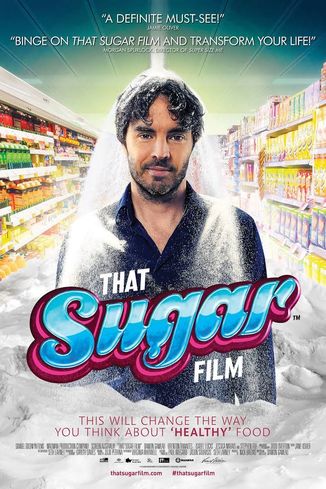 That Sugar Film, 2015, written and directed by Damon Gameau, who also stars. Streaming is available for free through Amazon Prime, or you can rent to stream or buy the DVD if you’re not a Prime member. Also available through Netflix.
That Sugar Film, 2015, written and directed by Damon Gameau, who also stars. Streaming is available for free through Amazon Prime, or you can rent to stream or buy the DVD if you’re not a Prime member. Also available through Netflix.
I don’t want to wear out my welcome here, so if you’re kind of weary of the whole “sugar is evil” hoopty-doo feel free to skip this. However, Jim and I thoroughly enjoyed this film, and it’s a pretty painless way (except for the tooth-extraction scene) to find out a little more about the silent white killer. (Cue ominous music. And full disclosure: I just caved in and ate three smallish peanut-butter cookies that my husband made this weekend. They were calling out to me from the freezer. But I won’t say that I couldn’t resist. I could. I just didn’t. So sue me!)
Gameau is an actor who decided to make a documentary about what would happen to him if, after about three years of eating a very healthful, low-to-no-sugar diet, he deliberately ate 40 teaspoons of sugar every day for 60 days, yet another one of those “stunt journalism” stunts, akin to “Supersize Me,” the 2004 film in which Morgan Spurlock, an American filmmaker, ate nothing but McDonald’s food for a month.
Gameau does something a little different from what you might expect: he doesn’t live on donuts and Twinkies. Instead, he limits his diet to foods that are considered “healthy” by the mainstream. He doesn’t eat ice cream, but he does eat sweetened fruit-flavored yogurt, for example. He drinks juice, not pop. He doesn’t eat candy bars, but he does eat granola bars. You get the picture.
And he spares no expense. He assembles a team of medical and nutritional experts. He travels to the Australian outback and to America. (There he visits a town in Kentucky where he runs into the 17-year-old boy with the rotten teeth who has been drinking Mountain Dew his whole life. I don’t quite know how they were able to film the dentist’s extraction tool going into the kid’s mouth. It’s pretty gruesome. And they have to stop because there’s so much infection that the Novacain isn’t working.)
Anyway, a few caveats are in order about this film. At least one of the medical experts Gameau uses is pretty much of a crank, as per a review of the film in Slate. (But we all know how liberal Slate is, right? So what do they know?) Gameau says that the typical Australian (where he’s from) diet includes 40 teaspoons of sugar a day, or 160 grams. Slate says that the typical American diet includes 18 teaspoons of sugar a day, or about 72 grams, less than half that. But when I went online and looked up “typical American sugar intake per day” I found a very reasonable-sounding article from just a year ago that said Americans eat about 140 grams, which translates to 35 teaspoons. So Gameau probably isn’t all that off. The Slate article also says that the so-called “fatty liver disease” that Gameau develops within weeks is based on a blood test that isn’t considered to be very reliable for that diagnosis. But there’s no question that this condition is becoming more and more common, as is diabetes, high blood pressure, metabolic syndrome . . . something must be causing all this. Gameau goes a little off the deep end when he implies that sugar may be the engine driving capitalistic greed. You can safely ignore that part. And if your sugar levels are normal I don’t see why you can’t have some white potatoes, pasta, and an occasional sweet. (But not me, I guess. Just took a blood sugar reading about an hour after the aforementioned cookie indulgence and my glucose was 181. Not good. I guess I’d better quit experimenting on myself.) As long as you keep your added sugar per day to 20-25 grams, you’re probably good, all other things being equal. But when you start keeping track of your added sugars you’ll probably be very surprised at how little that really is.
The film ends with a music-video-like sequence that’s worth the price of the whole film. So watch it, get to know Gameau, and perhaps start living a life that’s a little less sweet.